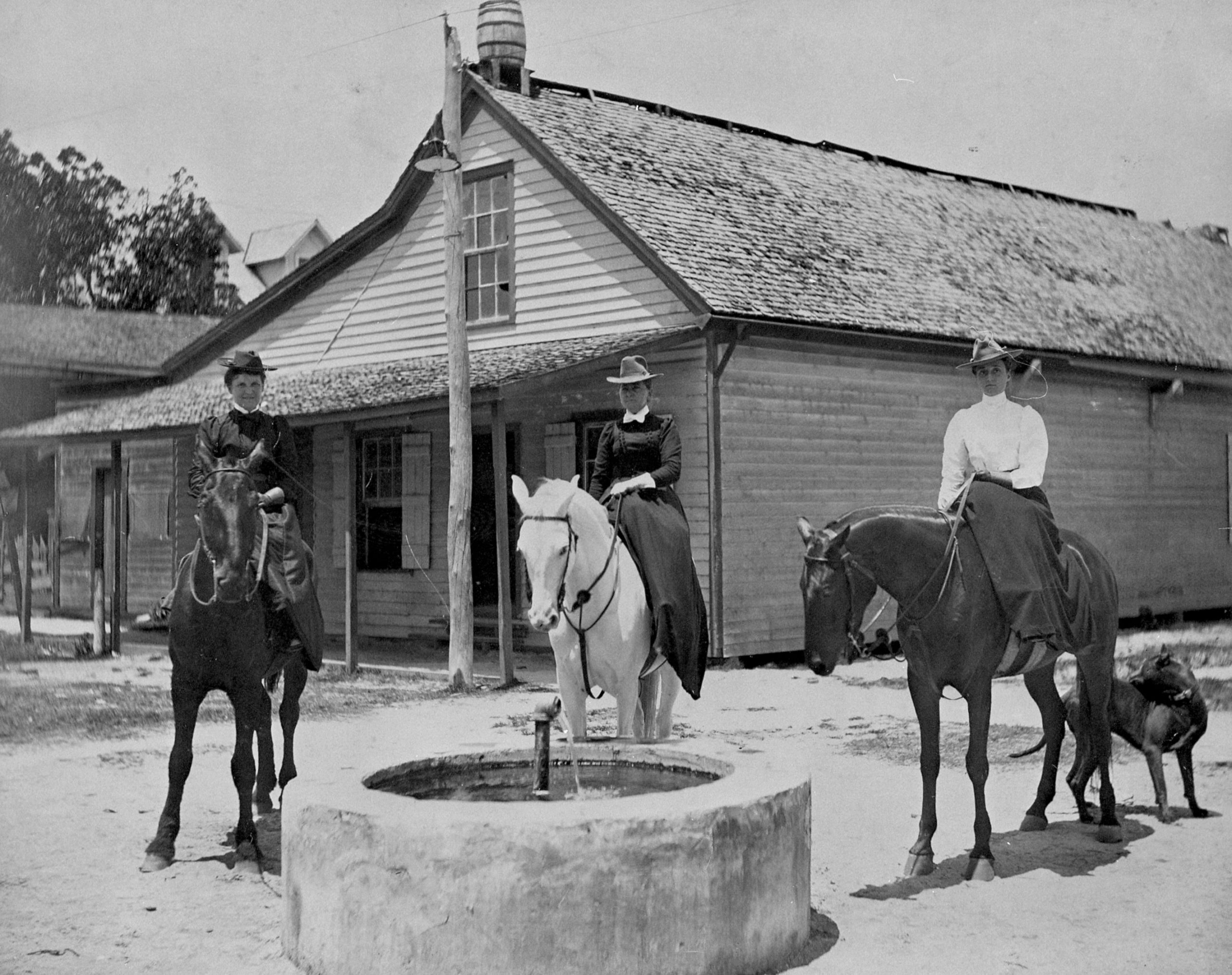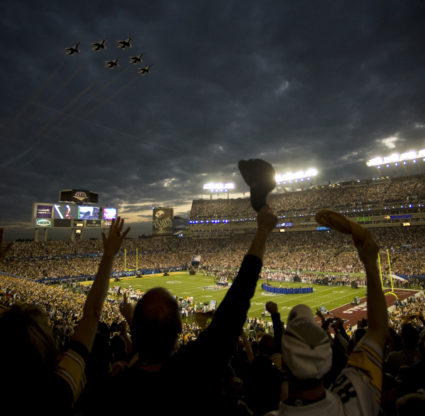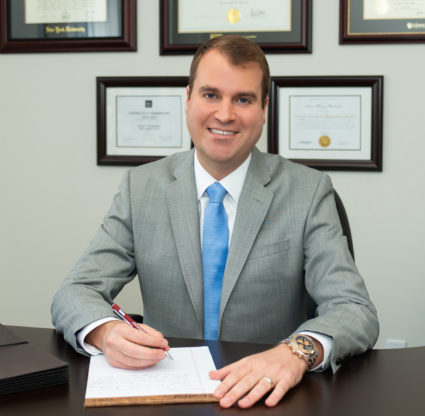The Sidney & Berne Davis Art Center stands on the northeast corner of First and Jackson streets in downtown Fort Myers. A gracious 1930s neoclassical structure, it’s today the center of a lively community arts program and a prime spot for exhibits, galas and other happenings. The woman whose name the building bears, the late Berne Davis, was 18 years old when she moved to town the summer of 1933. Then Bernese Barfield, six years away from marrying clothier Sidney Davis, she had just graduated Fort Myers High School. She moved into town from Slater (North Fort Myers) to work for real estate entrepreneur Bill Reynolds, who owned several businesses as well as a yacht he kept docked at the end of Hendry Street. Could she have imagined, watching the hundreds of men working on the building, that its destiny would one day be so tied up with her name? But it was always a place where destiny twined with the unexpected, an address essential to the history of Fort Myers. In fact, it was where it all began.
1850-1858:
ESTABLISHING FORT MYERS
When the U.S. Army set up a landmark fort on the Caloosahatchee River in 1850, it built its wooden officers’ quarters right where the SBDAC sits today. The Second Seminole War was over, but the Army feared renewed hostilities from the Seminole Indians who occupied the eastern prairie lands (where U.S. 29 is now) and southern hammocks. Early Fort Myers settler F.A. Hendry, who visited the fort in 1854, described it as a tropical paradise, with shell-lined paths where the men could walk in the balmy air, and with shiny barracks and work buildings.
 |
|
F.A. Hendry |
In 1856, Fort Myers gained one of its most famous residents, Winfield Scott Hancock. His exploits in the later Civil War earned him the nickname “Winfield the Superb,” but in 1856, he was a trusted soldier following his boss, Gen. William Selby Harney. Hancock brought his wife, Almira, and their young son. After they arrived to occupy the officers’ quarters, the army began engaging with Seminole leader Billy Bowlegs in what came to be known as the Third Seminole War.
Except for a few scattered letters from other parties, Almira Hancock’s Reminiscences of Winfield Scott Hancock are the only day-to-day descriptions of life at the fort at this time. She published the book a year after her husband’s death in 1886.
Her Fort Myers is a study in contrasts: The only milk was from “half-starved Florida cows,” but she served a fine dinner every night to as many young soldiers as would fit at her table. The constant threat of violence kept her and her son confined to the fort and its long wharf, but the war whoops the soldiers on guard duty heard were usually their own imaginations. She reports that the soldiers who died at this time were mostly the victims of “swamp fever” or friendly fire, not American Indians.
The Hancocks were at the fort for only a year, but during this time they had their daughter, Ada. (She was once dubiously described as “the first white child born in Fort Myers.”) In honor of her birth, on Feb. 24, 1857, Hancock planted a palm. Wherever Hancock went, his wife wrote, he planted at least one tree, so that the men who succeeded him would always have something to enjoy. He imagined returning to one of his former posts and asking someone to speculate how a tree got there, never letting on that he had planted it. We know about his planting this one because he visited the city of Fort Myers again later in life, possibly when he was running for president in 1880. It was said that he told those present that he had planted it on the day Ada was born. Later the story got mixed up and had a newborn Ada planting the tree; but in every version, the man who told the story was choked with grief. Ada, that “fair and tender” plant, as her mother described her, had died in 1875 at the age of 18.
1859-1861:
PRIVATE SPECULATION
The war at the fort ended quietly. Harney left for Kansas, then Utah, protecting other frontier interests, and he took the Hancocks with him. Billy Bowlegs and about 150 other Seminoles met the steamer Gray Cloud at the wharf in Fort Myers in 1858 and went west by way of New Orleans. The Southwest Florida forts, including Fort Myers and its officers’ quarters, sat idle. But too many people remembered the tropical paradise for it to stay empty for long.
Oranges, grapefruits, pineapples, guavas—all could grow here. Word made its way up north. James Evans, part-owner and managing agent of the Virginia-based Florida Land Association, showed up in 1859 with ambitious plans for groves of tropical fruits, coffee and more. To the site of the old army fort, he brought with him a group of slaves, whose presence was hidden for many years by an accepted history that painted Evans as a lone gentleman farmer (as told in Karl Grismer’s The Story of Fort Myers). He planted much and left without seeing it come to fruition. In 1861, at the start of the Civil War, when it was likely the fort would be reactivated for the Federal Army, Evans went back to Virginia to fight for the Confederates.
1861-1865:
THE CIVIL WAR
The site of the old officers’ quarters and the fort itself were recommissioned for the Civil War. Although the county itself was later named after Confederate Robert E. Lee, Fort Myers was a federal garrison, a Union hold. A Capt. Doyle commanded the federal troops, joined by a few straggling rural families as well as escaped slaves. The soldiers were trying to prevent Florida cattlemen from shipping their skinny beef cows to the Confederate states. When the battle of Fort Myers was fought on Feb. 20, 1865, the Union men successfully repelled the Rebel attackers. The fort was decommissioned later that month, and our site sat idle for at least another year.
1866:
MANUEL A. GONZALEZ, FIRST SETTLER
Enter Manuel Antonio Gonzalez, Fort Myers’ first official post-fort settler. Born in Spain in 1832, Gonzalez immigrated to Cuba as a young man, then moved to Key West, where he became a citizen in 1859. During the war years, he ran a mail boat between Key West and Tampa. The abandoned fort that had been Fort Myers caught his imagination. Gonzalez brought his young son, Manuel S. Gonzalez; his brother-in-law, John Weatherford; and family friend Joseph Vivas to the fort in 1866 to found a town.
Writing as an older man, Manuel S. remembered that the place he came to as a 5-year-old had been “abandoned and left to the mercy of the world.” He and his father sent Weatherford and Vivas back to Key West for Gonzalez’s wife and daughter and Vivas’ wife, and instructions to fill the boat with supplies. The Gonzalez father and son picked out the officers’ quarters, where the SBDAC sits, as their home. It and the other buildings had been alarmingly stripped, Manuel S. said, of much of their lumber by “coastwise marauders.” Manuel S. and his father “scrapped around here and yonder” and secured materials to replace what had been plundered, while they waited the interminable three weeks for the rest of the party to return.
Within short years, the founding family of Fort Myers was joined by other families: the Powells, the Clays, the Hendrys, the Wilsons. Mrs. Manuel A. Gonzalez, Evelina, held school in the old quarters until a building could be built for that purpose. In 1872, James Evans, now with “Major” on his name, reappeared with a homestead claim related to his old tropical fruit endeavor. His land company had dissolved in 1869, and this time he did come back as a lone farmer. After winning his claim to land owned by settlers (and interrupting a move by the International Telegraph company to co-opt the land), he sold the settlers’ parcels back to them, including Gonzalez’s.
By then, Manuel A. Gonzalez had a large family. He moved them a couple of miles south, to what is now Manuel’s Branch, where a bas-relief inscription at the creek honors him today. Manuel S. Gonzalez became a pillar of the town. He was a builder responsible for the homes of many prominent citizens as well as the two houses that comprise today’s The Veranda restaurant, a few blocks away from the SBDAC site.
1880s-1910:
HAPPY FAMILIES AND THE HANCOCK PALM
During the 1880s, cattleman James E. Hendry (oldest son of F.A. Hendry) and his family lived at what was variously called “the old officers’ quarters” and “the old Gonzalez house.” In 1884 the town got its first newspaper, the Fort Myers Press, and there was no detail in its citizens’ lives that was unfit for print. The Press reported breathlessly, in June 1888, that the Hancock date palm was bearing fruit for the first time. By then, it was like a municipal good luck charm.
Hendry re-landscaped and renovated the home, while leaving some of the most identifying characteristics, like the army-original cistern in front of the home. He sold the parcel to Englishman R.I.O. Travers, who did tear down the cistern (front-page news at the time). Travers married Lady Julia Hendry (niece of F.A. Hendry) in a huge wedding in 1897, and the two lived there five more years before selling it to Florida and Harvie Heitman.
More than almost anyone, Harvie Heitman is responsible for the look of downtown Fort Myers. He came to town in 1888, at just 16 years old, to clerk for his uncle’s store. By 1894, he had started his own grocery business on the northwest corner of First and Jackson, just opposite the old officers’ quarters. He would build the area’s first brick buildings with the help of out-of-town bricklayers and masons. Local doyenne Tootie McGregor was impressed with his business sense, and she helped him build the Bradford Hotel in 1905. He followed that with a string of successful real estate and business ventures.
When he and Florida moved to the old officers’ quarters, he had a great view of the town he had done so much to grow. In his own yard, he could also see the magnificent Hancock palm, a link to the past.
Then came the storm. Thomas Gonzalez, in his book The Caloosahatchee, says the Hancock palm suffered tremendous damage in the hurricane of 1910, a legendary storm that also took out large parts of what are now Lee and Collier counties. Heitman was determined to save the tree, with braces, wires, experts, but it was gone forever when another storm hit in 1921. Heitman, already very ill, died in 1922.
1933:
IN WITH THE NEW
The Great Depression started for most Americans in 1929. It had already been going on in Fort Myers for a while. Fort Myers, which had been a booming real estate market since 1910, had its fortunes shattered by a 1925 storm that made cash tight. Before the bust, the Heitman family, Harvie’s widow and his brother wanted to build a luxury hotel on the site of the officers’ quarters/old home. They gifted the home to the city, which moved it to Jackson and Bay streets, where it became the public library. (It was demolished in 1937.) The piece of land where the officers’ quarters’ had been—the most central address in the city—sat vacant.
 In the early 1930s, through President Roosevelt’s Works Progress Administration, the federal government was putting the American people back to work with ambitious building projects across the country. More importantly, it was putting lots of money into municipal projects, and wily Fort Myers had scored a nice chunk of funds. By summer 1933, the government had purchased the property at First and Jackson from the Heitmans and was building a $200,000 neoclassical-style post office on the site (right).
In the early 1930s, through President Roosevelt’s Works Progress Administration, the federal government was putting the American people back to work with ambitious building projects across the country. More importantly, it was putting lots of money into municipal projects, and wily Fort Myers had scored a nice chunk of funds. By summer 1933, the government had purchased the property at First and Jackson from the Heitmans and was building a $200,000 neoclassical-style post office on the site (right).
It was designed by Nathaniel Gaillard Walker, a native South Carolinian who had established a firm in Fort Myers. Walker was the president of the state chapter of the American Institute of Architects and a highly regarded wunderkind. The building was two stories, not counting the basement, a feature that itself was unusual. Its eight-columned façade was of native Florida limestone, etched with coral formations. Shiny brass boxes along the front loggia granted 24-hour access to the post. Inside, marble elements in the lobby and staircase shone, and masons put numerous master touches throughout the interior. WPA-sponsored artists added such whimsical details as cherubs on the interior ceiling.
Hundreds crowded the steps for the dedication, on Dec. 9. 1933, where Walker was also granted the title of honorary postmaster.
1967-2000:
THE FEDERAL BUILDING
 The post office was the center of city life for decades to come. Pretty girls held drives for war bonds on the corner during World War II, and postcards from decades past show every make and model of shiny new car parked in front of the city’s most iconic building. Still, in the interest of roaring 1960s efficiency, Fort Myers abandoned the building in 1965.
The post office was the center of city life for decades to come. Pretty girls held drives for war bonds on the corner during World War II, and postcards from decades past show every make and model of shiny new car parked in front of the city’s most iconic building. Still, in the interest of roaring 1960s efficiency, Fort Myers abandoned the building in 1965.
In 1967, it got new life as a federal building and courthouse, the center of jurisprudence for the late Fort Myers justice George W. Whitehurst, a tall, red-headed beloved figure about whom legends are still told. When the building was converted to a courthouse, the open-air front with the post office boxes was sealed up, and the main entrance diverted from First Street. Dropped ceilings hid the artists’ original work on the decorative plaster ceilings, and some of the building’s most iconic interior features were covered up in the process of creating judge’s chambers, a gallery and other parts of a working courthouse.
In 1983, an Act of Congress dedicated the building as the “George W. Whitehurst Federal Building and United States Courthouse” (which remains its “official” name). In 1999, shortly after federal court was moved to a new building, the United States General Services Administration sold the building to the city for $185,000.
2001-present:
LET THERE BE LIGHT—AND ART
The grand old building was starting to chip on the outside, fade and leak on the inside. Rain infiltrated in spots, and non-historic elements introduced in the 1960s—like asbestos-laden material—weren’t aging well. The roof was going, and numerous windows were out.
 |
|
Berne Davis |
The building was on her way to being a beautiful eyesore. Then, in 2001, Florida Power & Light commissioned Caloosahatchee Manuscripts from famed sculptor Jim Sanborn. Sanborn’s work, which uses cylindrical structures to guide pinpoints of light, is also featured at the Central Intelligence Agency’s headquarters in Virginia. The 10-foot-tall dual columns in Fort Myers feature two distinct bits of content: One is a collection of the Latin names of the plants used in Thomas Edison’s Fort Myers lab experiments, and the other is a Native American journey story. The words expressed by the interior light of the columns throw themselves into relief on the native Florida stone of the building. There’s no sight quite like it, anywhere.
A group of city arts enthusiasts were determined to save the building, which many thought already too far gone. Florida Arts Inc., headed by professional musician Jim Griffith, leased the building from the city in a 99-year deal in 2003 and renovation began. It was estimated that the long-term renovation and conversion of the building would take about $4 million. Grants helped the team replace the roof and repair numerous historic elements, while taking out non-historic ones. The effort was helped along by a host of benefactors including John and Ellen Shepherd, the Fox family, Pamela Templeton and many others.
The guiding angel of the project became Berne Davis. A generous donation in 2006 put her name and the name of her late husband, clothier Sidney Davis, on the building. Inside, the grand atrium and mezzanine areas have been restored, and the gracious old windows shine. The building now boasts classrooms, a greenroom, performance space, exhibit space and more, all of it carved out with respect for the building’s original historic layout. A rooftop sculpture garden is in the works. A capital campaign by Florida Arts Inc. restored the old post office boxes, and the grand entrance was reopened.
When Berne Davis died in March 2016, a day after her 102nd birthday, the steps of the center filled with bouquets of flowers in a makeshift memorial to this queen of the arts. It was another in a long line of moments of grace and history at this site, the heart of the city for so long.
 |
|
The Caloosahatchee Manuscripts installment illuminates the Sidney & Berne Davis Art Center. |




